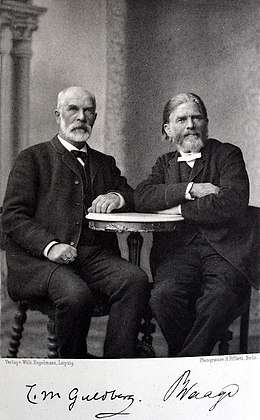Cato Maximilian Guldberg
Cato Maximilian Guldberg (11 August 1836 – 14 January 1902) was a Norwegian mathematician and chemist. Guldberg is best known as a pioneer in physical chemistry.[1][2]
Cato Maximilian Guldberg | |
|---|---|
.jpg) Cato Maximilian Guldberg (1891) | |
| Born | 11 August 1836 Christiania (now Oslo), Norway |
| Died | 14 January 1902 (aged 65) Kristiania (now Oslo), Norway) |
| Nationality | Norwegian |
| Alma mater | Royal Frederick University |
| Known for | Law of mass action |
| Awards | Order of St. Olav Order of the Dannebrog Order of Vasa Order of the Polar Star Order of Charles XIII |
| Scientific career | |
| Fields | Mathematics Chemistry |
| Institutions | Royal Frederick University |
| Influences | Peter Waage |

Background
Guldberg was born in Christiania (now Oslo), Norway. He was the eldest son of Carl August Guldberg (1812–92) and Hanna Sophie Theresia Bull (1810–54). He was the brother of nurse and educator Cathinka Guldberg. He attended Aug. Holths private latinskole in Christiania. Guldberg studied mathematics and physics at the University of Christiania and took his diploma in 1859. That same year he received the Crown Prince's gold medal (Kronprinsens gullmedalje) for a dissertation in pure mathematics. He received a travel and education scholarship in 1861, studying applied mathematics and machine learning in (Germany), Switzerland and France.[3] [4]
Career
Guldberg first taught at Hartvig Nissens skole in Christiania. Gulberg worked at the Royal Frederick University becoming a college fellow in 1867 and received a professorship in applied mathematics in 1869. Together with his brother-in-law, Peter Waage, he proposed the law of mass action. This law attracted little attention until, in 1877, Jacobus Henricus van 't Hoff arrived at a similar relationship and experimentally demonstrated its validity.[5][6]
In 1890, he published what is now known as the Guldberg rule, which states that the normal boiling point of a liquid is two-thirds of the critical temperature when measured on the absolute scale.[7]
From 1866 to 1868, 1869 to 1872 and 1874 to 1875 he was the chairman of the Norwegian Polytechnic Society.[8]
Honours
.svg.png)

- Knight of the Order of Vasa, 1866[10]
- Knight of the Polar Star, 1882
- Knight of St. Olav, 1891; Commander 2nd Class, 21 January 1896
- Knight of the Order of Charles XIII, 28 January 1899

References
- Bjørn Pedersen. "Cato M Guldberg". Store norske leksikon. Retrieved 1 February 2018.
- "Cato Guldberg, Norwegian chemist". Oxford University Press. Retrieved 1 February 2018.
- "Stud. real. Cato Maximilian Guldberg (1859)". University of Oslo. Retrieved 1 February 2018.
- Bent Birkeland. "Cato M Guldberg". Norsk biografisk leksikon. Retrieved 1 February 2018.
- Waage, P.; C. M. Guldberg (1864). "Studies Concerning Affinity". Forhandlinger: Videnskabs – Selskabet i Christinia. Norwegian Academy of Science and Letters: 35.
- Abrash, Henry I.; Gulberg, C. M. (1986). "Studies Concerning Affinity". Journal of Chemical Education. 63 (12): 1044–1047. Bibcode:1986JChEd..63.1044W. doi:10.1021/ed063p1044.- English translation of Waage and Guldberg's 1864 paper (above)
- Bowden, S. T. (1954). "A Corrected Guldberg Rule". Nature. 174 (4430): 613. Bibcode:1954Natur.174..613B. doi:10.1038/174613b0.
- "PFs formenn 1852 – 2004" (in Norwegian). Norwegian Polytechnic Society. Archived from the original on 24 July 2011. Retrieved 27 November 2009.
- Anton Anjou (1900). "Utländske Riddare". Riddare af Konung Carl XIII:s orden: 1811–1900: biografiska anteckningar (in Swedish). pp. 180-181.
- Sveriges Statskalender (in Swedish), 1877, p. 449, retrieved 29 May 2020 – via runeberg.org
- Bille-Hansen, A. C.; Holck, Harald, eds. (1900) [1st pub.:1801]. Statshaandbog for Kongeriget Danmark for Aaret 1900 [State Manual of the Kingdom of Denmark for the Year 1900] (PDF). Kongelig Dansk Hof- og Statskalender (in Danish). Copenhagen: J.H. Schultz A.-S. Universitetsbogtrykkeri. pp. 139–140. Retrieved 16 September 2019 – via da:DIS Danmark.
Publications
- Waage, P.; C. M. Guldberg (1864). "Studies Concerning Affinity". Forhandlinger: Videnskabs – Selskabet i Christinia. Norwegian Academy of Science and Letters: 35.
- Abrash, Henry I.; Gulberg, C. M. (1986). "Studies Concerning Affinity". Journal of Chemical Education. 63: 1044–1047. Bibcode:1986JChEd..63.1044W. doi:10.1021/ed063p1044.- English translation of Waage and Guldberg's 1864 paper (above)
Related reading
- Peter Østrøm. Guldberg and Waage on the Influence of Temperature on the Rates of Chemical Reactions (Centaurus. Volume 28, Issue 3. Pages 277–287. October 1985)
- Robin E. Ferner and Jeffrey K. Aronson. Cato Guldberg and Peter Waage, the history of the Law of Mass Action, and its relevance to clinical pharmacology (Br J Clin Pharmacol. 2016 Jan; 81(1): 52–55)
External links
- "World of Chemistry on Cato Guldberg". Bookrags. Retrieved 7 July 2008.
| Preceded by H. Koch |
Chairman of the Norwegian Polytechnic Society 1866–1868 |
Succeeded by Peter Waage |
| Preceded by Peter Waage |
Chairman of the Norwegian Polytechnic Society 1869–1872 |
Succeeded by Johannes Benedictus Klingenberg |
| Preceded by Johannes Benedictus Klingenberg |
Chairman of the Norwegian Polytechnic Society 1874–1875 |
Succeeded by Hans Jacob Rosenørn Grüner |